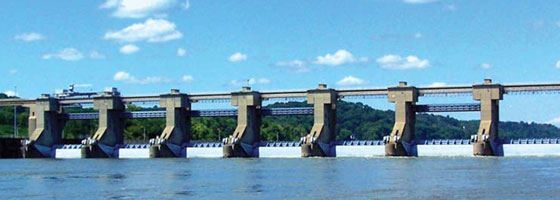Ohio River dams offer alternative energy through hydroelectric power

The Ohio River begins at the confluence of the Allegheny and Monongahela Rivers in Pittsburgh, and flows mostly southwest for 981 miles. The Ohio River drains an area of about 204,000 square miles and empties into the Mississippi River at Cairo, Illinois.
The Ohio is second only to the Mississippi River for transported cargo. The river serves some of the nation’s busiest industrial cities, richest farmlands and most productive coal fields. Coal makes up almost half the total freight shipped on the Ohio. Other major cargo includes agricultural products, chemicals, crushed rock, gravel, petroleum products, sand, and steel products.
Recognizing the importance of the Ohio River as an inland waterway, U.S. Congress authorized the Army Corps of Engineers to construct multiple wing dams or dikes along the River in 1824. In spite of these efforts, safe navigation was still sporadic and seasonal. The first complete lock and dam project built by the Corps of Engineers on the Ohio was at Davis Island, a few miles downriver of Pittsburgh. This lock and dam opened to traffic in 1885.
In 1910, Congress passed the Rivers and Harbors Act, which authorized construction of a river-length system of locks and dams to provide a nine-foot navigation depth. When completed in 1929, the “canalization” project consisted of fifty-one movable dams with wooden wickets and a lock chamber measuring 600 feet by 110 feet.
In the 1950s, the Army Corps undertook the Ohio River Navigation Modernization Program to replace the obsolete system of wicket dams and small locks with new high-lift concrete and steel dams. These dams allow a towboat and up to fifteen barges to transit the lock in one maneuver. At many of these dams, hydroelectric power plants have been constructed to generate electricity for nearby cities and residents.
Hydroelectricity is power generated from moving water, and it is a clean and renewable source of energy. Hydroelectric plants generate energy without emitting atmospheric pollutants or contributing to global warming. Hydropower is the primary contributor of renewable energy in the United States and can be produced as long as rain falls and rivers flow.
While the benefits of hydroelectric plants certainly outweigh the costs, the construction of these plants can be disruptive to surrounding aquatic ecosystems. The impact of the dissolved oxygen content of the water from pre-construction conditions is of particular interest.
The Federal Energy Regulatory Commission, or FERC, is an independent agency that licenses and inspects private, municipal, and state hydroelectric projects. Hydroelectric power regulation was first undertaken in 1920, and the Commission is now responsible for over 2,600 licensed and exempted dams and related water retention structures. Many FERC licenses require that the Hydroelectric Plant monitors the water quality at certain locations upstream and downstream of the plant.
Fondriest Environmental has worked with many hydroelectric plants along the Ohio River to provide real-time dissolved oxygen monitoring systems, including Willow Island, Belleville, Racine, Cannelton, and Smithland dams.




0 comments